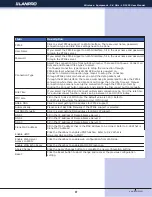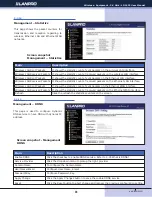
www.lanpro.com
Wireless - Equipment - 2.4 GHz - LP-1522 User Manual
35
What is Beacon Interval?
In addition to data frames that carry information from higher layers, 802.11 includes management and control frames
that support data transfer. The beacon frame, which is a type of management frame, provides the “heartbeat” of a
wireless LAN, enabling stations to establish and maintain communications in an orderly fashion.
Beacon Interval represents the amount of time between beacon transmissions. Before a station enters power save
mode, the station needs the beacon interval to know when to wake up to receive the beacon (and learn whether there
are buffered frames at the access point).
4.12
What is Preamble Type?
There are two preamble types defi ned in IEEE 802.11 specifi cation. A long preamble basically gives the decoder more
time to process the preamble. All 802.11 devices support a long preamble. The short preamble is designed to improve
effi ciency (for example, for VoIP systems). The difference between the two is in the Synchronization fi eld. The long
preamble is 128 bits, and the short is 56 bits.
4.13
What is SSID Broadcast?
Broadcast of SSID is done in access points by the beacon. This announces your access point (including various bits of
information about it) to the wireless world around it. By disabling that feature, the SSID confi gured in the client must
match the SSID of the access point.
Some wireless devices don’t work properly if SSID isn’t broadcast (for example the D-link DWL-120 USB 802.11b
adapter). Generally if your client hardware supports operation with SSID disabled, it’s not a bad idea to run that way
to enhance network security. However it’s no replacement for WEP, MAC fi ltering or other protections.
What is Wi-Fi Protected Access (WPA)?
Wi-Fi’s original security mechanism, Wired Equivalent Privacy (WEP), has been viewed as insuffi cient for securing
confi dential business communications. A longer-term solution, the IEEE 802.Hi standard, is under development.
However, since the IEEE 802. Hi standard is not expected to be published until the end of 2003, several members
of the Wi-Fi Alliance teamed up with members of the IEEE 802. Hi task group to develop a signifi cant near-term
enhancement to Wi-Fi security. Together, this team developed Wi-Fi Protected Access.
To upgrade a WLAN network to support WPA, Access Points will require a WPA software upgrade. Clients will require
a software upgrade for the network interface card, and possibly a software update for the operating system. For
enterprise networks, an authentication server, typically one that supports RADIUS and the selected EAP authentication
protocol, will be added to the network.
What is WPA2?
It is the second generation of WPA. WPA2 is based on the fi nal IEEE 802.1H amendment to the 802.11 standard.
What is 802.lx Authentication?
802.lx is a framework for authenticated MAC-level access control, defi nes Extensible Authentication Protocol (EAP) over
LANs (WAPOL). The standard encapsulates and leverages much of EAP, which was defi ned for dial-up authentication
with Point-to-Point Protocol in RFC 2284.
Beyond encapsulating EAP packets, the 802. lx standard also defi nes EAPOL messages that convey the shared key
information critical for wireless security.
4.14
4.15
4.16
4.17
What is Temporal Key Integrity Protocol (TKIP)?
The Temporal Key Integrity Protocol, pronounced tee-kip, is part of the IEEE 802.Hi encryption standard for wireless
LANs. TKIP is the next generation of WEP, the Wired Equivalency Protocol, which is used to secure 802.11 wireless
LANs. TKIP provides per-packet key mixing, a message integrity check and a re-keying mechanism, thus fi xing the
fl aws of WEP.
4.18


































